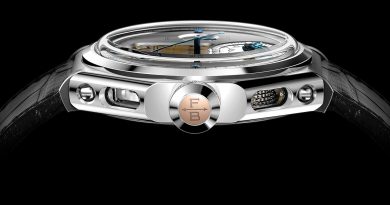The Power Trio: Naming, Typeface, and Logo in Watch Branding
A watch is no longer just about telling time. It’s an identity strapped to your wrist – a statement that reflects the taste, aspirations, or even the personality of the wearer. For those creating a new watch brand, it’s tempting to focus on the mechanics, materials, and movements. But before the case is even opened, something else has already shaped the buyer’s perception: the name, the typeface, and the logo. Get these right, and the watch becomes a cohesive, irresistible package. Get them wrong, and no amount of sapphire crystal or fine finishing will save it.
Let’s break down why this trifecta matters, how to approach it with intent, and why designers and founders shouldn’t treat it as an afterthought.
Naming: The first impression that lasts
A name lingers long after the specs are forgotten. It has to evoke something – heritage, aspiration, or curiosity. The best names often feel inevitable in hindsight. Rolex. Omega. Cartier. These names are short, sharp, and universal. They transcend language, hint at luxury, and stick in the mind.
But not every name has to be monolithic. Brands like Nomos Glashütte embrace their roots with longer, regionally influenced names. NOMOS conjures images of Bauhaus precision, while Glashütte grounds it in German horological heritage.
For newer brands, founders often wrestle with the dilemma: should the name reflect personal authenticity, or should it be bold and abstract? Both paths work if they’re executed with conviction. Consider Fears – a revived British brand that uses the original 1846 family name. There’s weight and history in that simplicity. Compare this to Hublot (French for porthole), a name that paints a clear image with an industrial edge.
Key takeaway: Whether personal or conceptual, a name should be memorable, easy to pronounce, and distinct within the market.
Typography: The subtle art of character
A brand’s typeface isn’t just for the website or the box – it’s etched onto the dial. It becomes part of the watch’s DNA. Every numeral, every letter matters.
Think of Cartier’s elegant serif numerals. They whisper of Parisian ateliers and timeless sophistication. Now contrast that with the blocky, industrial typeface Panerai uses – bold, legible, no frills. The typeface often mirrors the essence of the watch. Refined dress watches call for delicate, flowing scripts. Tool watches thrive on utilitarian clarity.
Choosing or commissioning a typeface isn’t simply a graphic design exercise. It should consider the scale (will it still read clearly on a 34mm dial?), the material (brass, enamel, or printed on matte dials?), and the longevity of the style (trendy or timeless?).
Bespoke typefaces, while more costly, offer unique signatures that set brands apart. Many top-tier watchmakers invest in exclusive lettering to reinforce their identity, ensuring even the typography feels crafted and considered.
Common pitfall: Over-designed or overly decorative typefaces can age poorly, making the watch feel dated within a decade. Simple, legible fonts with a hint of flair tend to endure.
Logo: The silent ambassador
A logo might be the smallest element, but it carries disproportionate weight. Logos appear on crowns, casebacks, clasps, and movements. They are literally everywhere.
Consider the Tudor rose, later replaced by the shield. Both convey strength, but the shield aligns better with Tudor’s modern positioning as a robust, adventure-driven brand. Conversely, Patek Philippe’s Calatrava cross remains unchanged, anchoring the brand to its spiritual and aesthetic roots.
Logos can be symbolic, typographic, or a hybrid of the two. A strong logo-mark should work at every size – from a macro view on the dial to a microscopic engraving on a buckle.
Minimalism often reigns supreme in luxury watch branding. Clean, understated logos carry an air of confidence. Negative space and simplicity ensure the mark remains timeless, avoiding trends that may fade.
Design tip: Sketch logo concepts with simplicity in mind. If it feels too complex at thumbnail size, it’s too complex.
Creating cohesion: Why it all has to work together
Individually, each element – the name, the typeface, the logo – plays a part. But their true strength lies in unity. A bold, masculine logo can clash with a delicate script typeface. A heritage-inspired name might feel disjointed if paired with hyper-modern typography.
Watch branding thrives on subtle consistency. The goal is to create an ecosystem where each piece reinforces the others, weaving an invisible thread that connects packaging, advertising, and the product itself. However, rebranding can be met with equal parts applause and displeasure from die-hard fans. A recent example is Bremont, whose new branding direction under fresh leadership sparked debate among long-standing collectors, some of whom felt the shift strayed from the brand’s established identity.
Examples to study
- Grand Seiko: The name suggests elevated precision. The logo’s lion emblem exudes quiet strength, while the refined typeface reflects meticulous craftsmanship.
- Audemars Piguet: The initials “AP” are monogrammed like jewellery. This echoes through their seamless combination of luxury and technical prowess.
- MB&F: Avant-garde in name and aesthetic. The mechanical, futuristic logo mirrors the radical designs of their timepieces.
- Christopher Ward: Understated British charm. The typeface is modern, the logo minimal, reflecting their fuss-free ethos.
Final thought
Branding isn’t an accessory to watch design – it’s part of the foundation. For founders and designers, investing thought and care into naming, typography, and logos doesn’t just elevate the watch; it shapes the perception of the entire brand. Approach this trio with the same precision you’d expect from the movement inside the case, and the result will resonate far beyond the dial.





